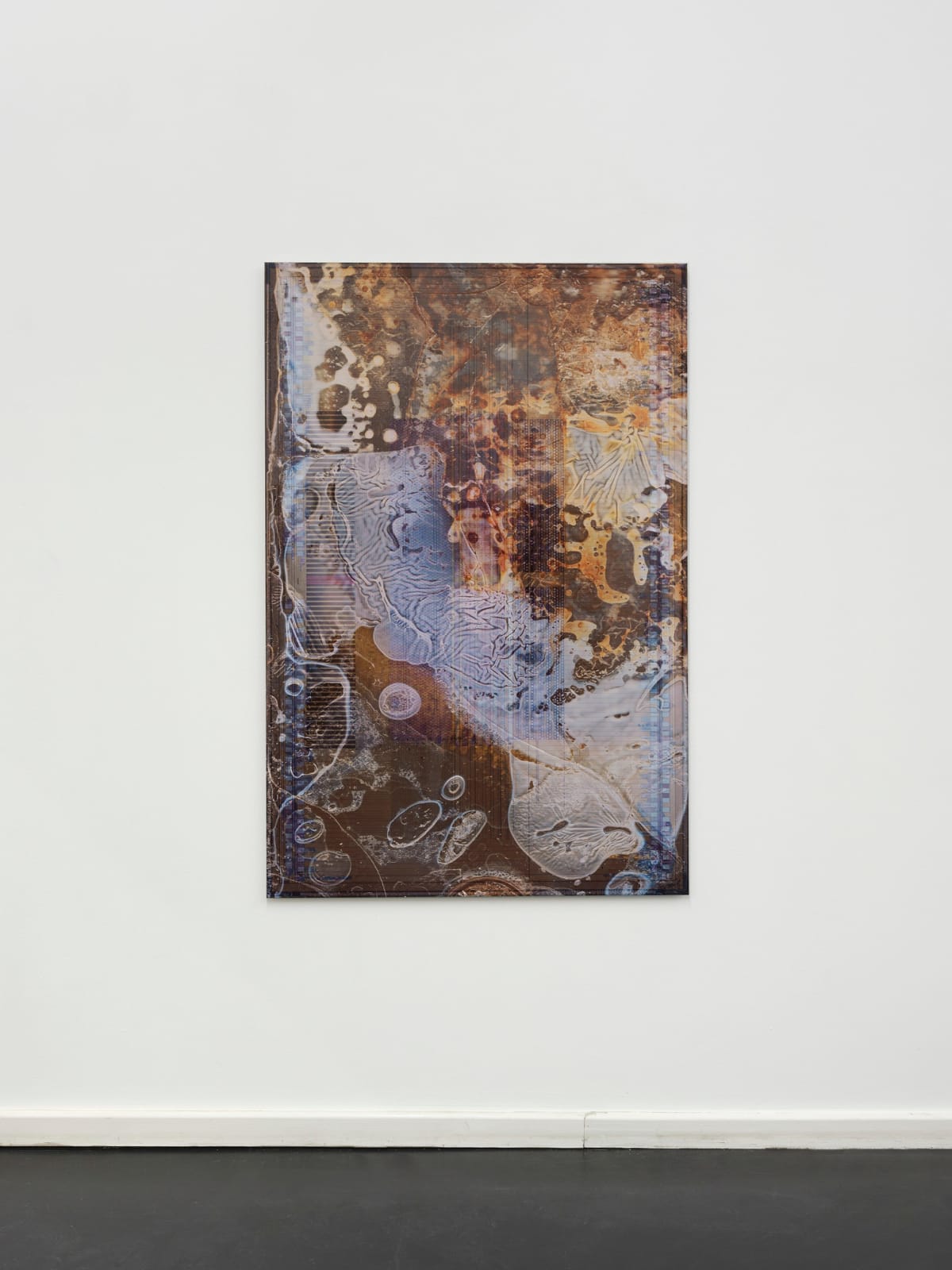Nicolás Lamas
Fluid minds, 2025
CromaLuxe on aluminum
150 x 100 cm
59 x 39 3/8 inches
59 x 39 3/8 inches
Ed. 1/1 + 1 AP
Copyright The Artist
Photo: Marjorie Brunet Plaza
Weitere Abbildungen
In „Fluid minds“ (2025) verdichtet sich Lamas’ Auseinandersetzung mit der Wandelbarkeit von Materie, Zeit und Bedeutung in einer Aluminiumfläche, die zugleich wie korrodiert und bearbeitet scheint. Die rechteckige Platte wirkt...
In „Fluid minds“ (2025) verdichtet sich Lamas’ Auseinandersetzung mit der Wandelbarkeit von Materie, Zeit und Bedeutung in einer Aluminiumfläche, die zugleich wie korrodiert und bearbeitet scheint. Die rechteckige Platte wirkt wie ein Geflecht aus Schlieren, Abnutzungsspuren und metallischen Reflexen – Spuren, die an geologische Prozesse oder organische Sedimentierungen erinnern. Wie in vielen seiner Werke begegnet uns auch hier eine hybride Form, die industrielle Glätte mit geologischer Textur verschränkt. Das verwendete Trägermaterial, CromaLuxe auf Aluminium, entstammt ursprünglich der digitalen Reproduktion – doch bei Lamas verliert es seine Funktion als bloßer Bildspeicher und wird zum Spiegel fluiden Denkens. In diesem Kontext verweist das Werk auf die Belebtheit des vermeintlich Starren. Aluminium, oft Symbol für industrielle Kälte und technologische Reproduzierbarkeit, wird hier zur organischen Membran und Träger von Einschreibungen, von Bewegungen, die jenseits menschlicher Zeitskalen operieren. Materie ist hier fluide Instanz, aktiver Akteur in einem zirkulierenden Netz von Bedeutungen, Spuren und Potentialen. Lamas schlägt eine andere Art der Wahrnehmung vor: weniger linear, weniger anthropozentrisch, sondern zyklisch und offen für Verschiebungen.
In “Fluid minds” (2025), Lamas' exploration of the mutability of matter, time and meaning is condensed in an aluminum surface that appears both corroded and processed. The rectangular plate looks like a network of streaks, signs of wear and metallic reflections - traces reminiscent of geological processes or organic sedimentation. As in many of his works, here too we encounter a hybrid form that interweaves industrial smoothness with geological texture. The carrier material used, CromaLuxe on aluminum, originally comes from digital reproduction - but in Lamas' work it loses its function as a mere image storage medium and becomes a mirror of fluid thought. In this context, the work refers to the vitality of the supposedly rigid. Aluminum, often a symbol of industrial coldness and technological reproducibility, here becomes an organic membrane and carrier of inscriptions, of movements that operate beyond human time scales. Here, matter is a fluid instance, an active player in a circulating network of meanings, traces and potentials. Lamas proposes a different kind of perception: less linear, less anthropocentric, but more cyclical and open to shifts.
In “Fluid minds” (2025), Lamas' exploration of the mutability of matter, time and meaning is condensed in an aluminum surface that appears both corroded and processed. The rectangular plate looks like a network of streaks, signs of wear and metallic reflections - traces reminiscent of geological processes or organic sedimentation. As in many of his works, here too we encounter a hybrid form that interweaves industrial smoothness with geological texture. The carrier material used, CromaLuxe on aluminum, originally comes from digital reproduction - but in Lamas' work it loses its function as a mere image storage medium and becomes a mirror of fluid thought. In this context, the work refers to the vitality of the supposedly rigid. Aluminum, often a symbol of industrial coldness and technological reproducibility, here becomes an organic membrane and carrier of inscriptions, of movements that operate beyond human time scales. Here, matter is a fluid instance, an active player in a circulating network of meanings, traces and potentials. Lamas proposes a different kind of perception: less linear, less anthropocentric, but more cyclical and open to shifts.





